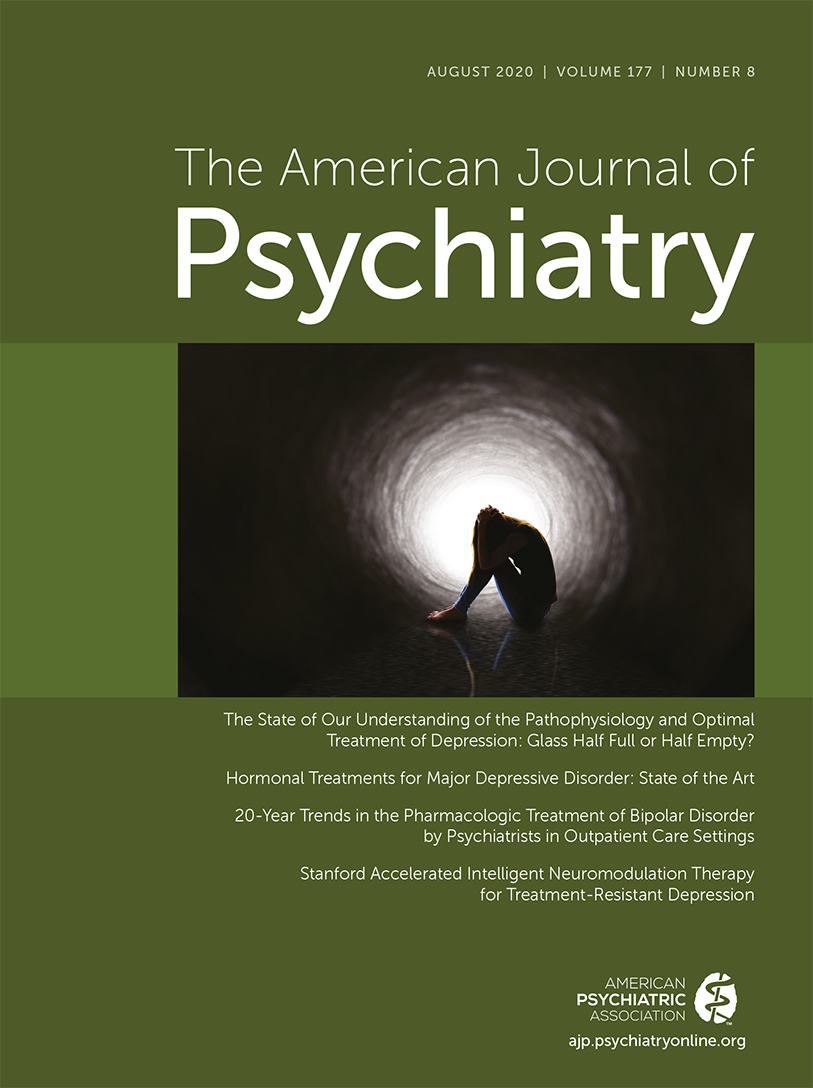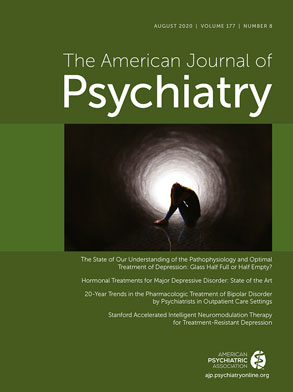While brain stimulation with magnetic fields may still seem like a “new” approach to many clinicians, more than a decade has passed since the first transcranial magnetic stimulation (TMS) device for treating major depressive disorder received regulatory approval from the U.S. Food and Drug Administration. Six other TMS devices have since been cleared for treatment-resistant depression in the United States, and multiple others have received similar regulatory approvals elsewhere around the world. It has been estimated that around 20 million TMS treatment sessions have been delivered since 2009 (personal communications with Magstim, Neuronetics, and BrainsWay representatives), and naturalistic treatment studies (
1) suggest that over half of depressed patients treated with TMS will benefit. These outcomes are remarkable for a population that has typically suffered for years or decades through multiple failed medication trials, often with severe and disabling symptoms, before trying TMS therapy.
Unfortunately, the commitment of time required for a course of TMS therapy is prohibitive for many patients. The current standard of care entails once-daily outpatient treatment sessions delivered in a specialized clinic 5 days per week for up to 6 weeks, typically followed by additional treatments in a taper scheduled over several more weeks. Upon arrival at the clinic, each session requires a clinical assessment, positioning of the patient and setting up the TMS coil on their head, and delivery of the stimulation protocol for 18–37 minutes.
For those who can access it, TMS therapy is often still not good enough. Nearly half of depressed patients who try TMS will not find relief from it, and it is not possible to reasonably predict which patients will be nonresponders until after multiple weeks of TMS sessions (
2). It is widely believed that outcomes would be better if we knew how and where to stimulate each individual patient’s brain. In current clinical practice, various steps are taken to promote consistency from one session to the next in placement of the TMS coil on the patient’s scalp over the targeted brain region—the dorsolateral prefrontal cortex (DLPFC). This is somewhat ironic, because the commonly used DLPFC target is not functionally defined and is probably not the ideal region for treating all depressed patients. Researchers have thus been busy exploring the brain network changes associated with TMS through functional MRI (fMRI) (
3) and EEG (
4), with the goal of identifying where or how to target stimulation (
5).
In this issue of the
Journal, Cole et al. (
6) describe the results of their study using an accelerated, high-dose, resting-state functional connectivity–guided intermittent theta-burst stimulation for treatment-resistant depression, called Stanford Accelerated Intelligent Neuromodulation Therapy, or SAINT. Despite the small sample size and unblinded design, this report reflects significant levels of innovation and creativity. The treatment produced very high levels of clinical remission, exceeding those observed in more traditional TMS studies, and the majority of the remissions occurred in the first 3 days of a 5-day course of treatment. This study illustrates how integrative thinking, combined with technical advances, may be leveraged to rationally design new treatments. As such, and to continue with the religious theme of the parent study’s “SAINT” acronym, we believe the study by Cole et al. is also a “RABBI,” i.e., a Rapid Advance By Brain stimulation Innovation—and its innovations can be grouped into three main areas: novel stimulation parameters, novel treatment administration, and novel targeting.
First, the authors used intermittent theta-burst stimulation (iTBS), which can be conceptualized as a second-generation form of TMS. Designed to mimic inherent hippocampal neuronal firing patterns, iTBS is a pattern of TMS that delivers triplets of 50-Hz stimulation called “bursts” every 200 ms (i.e., 5 bursts per second=5 Hz, a theta rhythm). Considering the total number of pulses, then, iTBS allows an entire therapeutic “dose” equivalent of stimulation to be delivered in 3–10 minutes—a fraction of the time required for standard TMS (
7). Whether the neurobiological basis of iTBS holds merit remains to be proven, but its rapid administration has already made an impact on the field. A course of therapy with iTBS was demonstrated to be noninferior to standard TMS for treatment-resistant depression (
8), and emerging evidence supports its therapeutic use in other disorders (e.g.,
9,
10). Because iTBS sessions are brief, administration protocols can be creative; for example, multiple stimulation sessions can be delivered in a single day with the goal of accelerating clinical effects. Cole et al. were able to deliver the equivalent of 6 weeks of standard TMS sessions in just 5 days.
Second, an important and unanswered question in the brain stimulation literature is timing: at what interval to deliver multiple sessions? Cole et al. provide a potential answer: Based on physiology data and the learning literature, they administered iTBS once every hour, to allow maximum effects of TMS-induced connectivity changes in key networks before applying subsequent stimulation (
11). This demonstrates how systems neuroscience and other fields of brain science research can be leveraged to inform clinical practice. This example may also provide guidance for investigations in which brain stimulation is combined with other cognitive interventions (
12). For example, when administering TMS plus psychotherapy, one can imagine wanting maximal neuronal effects to occur before engagement with the therapist.
The third innovation to highlight is the authors’ use of functional neuroimaging to define an individualized stimulation target. Cole et al. used resting-state fMRI, which is feasible to perform in symptomatic patients and is well suited for eventual clinical use. Resting-state neuroimaging data have already provided important insights into how to identify patients most likely to respond to TMS and for understanding how the brain changes in response to therapeutic stimulation (
3). In this case, the team measured functional connectivity between the treatment target—the DLPFC—and a deeper brain region implicated in the antidepressant response, the subgenual anterior cingulate (ACC) (
13). They used that connection to place the TMS coil on the scalp over the area that would be optimally connected to the ACC for antidepressant effects. Most importantly, targeting and placement of the coil on the patients’ heads was performed prospectively and at the single-subject level, thus demonstrating the feasibility of individualized precision medicine.
Despite these innovations, there are important caveats for interpretation of the trial results. As the authors point out, this was an uncontrolled study using a very small sample of patients, so the resulting effect sizes cannot be considered reliable (
14). The administration of all-day stimulation sessions certainly invokes the specter of placebo effects, regardless of the population under study. The field of brain stimulation, much like the rest of psychiatry, has often failed to replicate positive results under double-blind conditions (e.g.,
15). Thus, enthusiasm for these results must be tempered until we have results from a sufficiently powered randomized controlled trial.
The durability of the TMS effect and side effects reported by Cole et al. are also noteworthy. Nearly a third of the study participants lost their response to SAINT by 1 month, which makes one wonder about possible trade-offs between short-term, denser TMS treatment courses and longer-lasting neuroplasticity, which may be needed to sustain symptom relief. Furthermore, while reported side effects were few, there were significant rates of stimulation site discomfort (as might be expected when administering large amounts of TMS) and a case of treatment-emergent anxiety. While treatment site discomfort can be managed with analgesics, how to manage treatment-emergent anxiety is less clear; given the high comorbidity of depression and anxiety, these will be important issues to consider in the design of future confirmatory SAINT trials that could have an impact on standard clinical practice.
Finally, the methods and technology deployed by Cole et al. are, to put it mildly, not cheap. The cost of TMS, as it is currently delivered, is already substantially higher than most other depression treatment options. Neuroimaging, and particularly MRI, with the resources required to perform individualized connectivity analysis and deliver MRI-navigated stimulation, adds to the already considerable cost of TMS therapy. While shorter stimulation protocols such as iTBS are now available to improve clinical efficiency, we still do not know whether precision neuroimaging approaches will prove cost-effective. Without further studies that provide direct and robust comparisons between standard targeting methods and precision targeting such as that used in this study, these technical advances are unlikely to be justifiable for adoption outside of research settings.
These caveats notwithstanding, data from this pilot study suggest potential for transforming TMS therapy from remarkable to awesome. The report by Cole et al. highlights the fact that such a transformation is within our reach, and it leaves us eagerly awaiting controlled data to confirm that the time is now.

